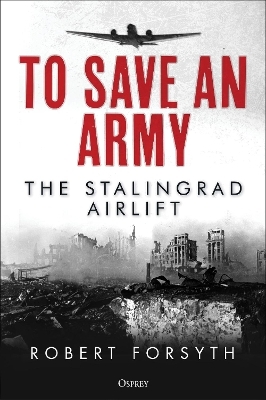
To Save An Army
Osprey Publishing (Verlag)
978-1-4728-4541-2 (ISBN)
Stalingrad ranks as one of the most infamous, savage and emotive battles of the 20th century. It has consumed military historians since the 1950s and has inspired many books and much debate. This book tells the story of the operation mounted by the Luftwaffe to supply, by airlift, the trapped and exhausted German Sixth Army at Stalingrad in the winter of 1942/43.
The weather conditions faced by the flying crews, mechanics, and soldiers on the ground were appalling, but against all odds, and a resurgent and active Soviet air force, the transports maintained a determined presence over the ravaged city on the Volga, even when the last airfields in the Stalingrad pocket had been lost.
Yet, even the daily figure of 300 tons of supplies, needed by Sixth Army just to subsist, proved over-ambitious for the Luftwaffe which battled against a lack of transport capacity, worsening serviceability, and increasing losses in badly needed aircraft.
Using previously unpublished diaries, original Luftwaffe reports and specially commissioned artwork, this gripping battle is told in detail through the eyes of the Luftwaffe commanders and pilots who fought to keep the Sixth Army alive and supplied.
Robert Forsyth is an author, editor and publisher, specialising in military aviation and military history. He is the author of over 25 titles for Osprey Publishing, on the aircraft, units and operations of the Luftwaffe, including Luftwaffe Special Weapons 192–45 and DUEL 97 Tempest V vs Fw 190D-9: 1944–45.
Part One: Conquest
- The Demyansk and Kholm airlifts – dangerous precedents, 1941-42
- A summary of the advance of Army Group South (later Army Groups A and B) towards the Don from July 1942 and war aims (to September 1942)
- The role and status of the Luftwaffe in support of German war aims in southern Russia from the summer of 1942, with focus on the Transportverbände, biographies of the airlift senior commanders such as Milch, von Richthofen, Fiebig, Pickert and Morzik, and the effect of their backgrounds and personalities on events; the transport units, their structures and the Luftwaffe’s multi-front commitments
- Detailed descriptions of the six principal transport aircraft used in the Stalingrad airlift: Junkers Ju 52/3m – Heinkel He 111 – Heinkel He 177 – Junkers Ju 290 – Focke-Wulf Fw 200 – Junkers Ju 86
Part Two: Crisis
- A summary of Zhukov’s counter-attack, Operation Uranus, launched on 19 November 1942, and the encirclement of Sixth Army four days later
- The decision by Hitler, Göring, Jeschonnek and the German high command to supply Sixth Army by air
- The commencement of airlift (Phase 1 to mid-December), with flights landing at Gumrak and Pitomnik airfields inside the pocket carrying mainly fuel and ammunition; day-by-day description of events, command decisions, flights, effect of weather, enemy reaction and movement, analysis of supplies and tonnages, serviceability, units deployed, weather conditions etc. Mainly fuel and ammunition to 19 December based on Sixth Army requests
- The stalling of the Hoth relief effort (Operation Winter Storm) by 23 December
Part Three: Catastrophe
- Phase 2 and the climactic, doomed airlift from 24 December, with even the main Luftwaffe airlift depot base at Tatsinskaya under threat. Day-by-day description of events, command decisions, flights, effect of weather, enemy reaction and movement
- From 26 December onwards the supply of food becomes the priority over ammunition and fuel
- On 12 January, Pitomnik airfield in the pocket is lost; landings increasingly give way to air-drops as conditions worsen. Gumrak airfield lost on 22 January
- Detail will range from the command decisions in Berlin, to air fleet and corps command-level, to operations by individual transport units
Aftermath and conclusions
Appendices
Index
| Erscheinungsdatum | 31.10.2022 |
|---|---|
| Zusatzinfo | A 32-page plate section with both colour and black and white images. |
| Sprache | englisch |
| Maße | 153 x 234 mm |
| Themenwelt | Natur / Technik ► Fahrzeuge / Flugzeuge / Schiffe ► Militärfahrzeuge / -flugzeuge / -schiffe |
| Geschichte ► Allgemeine Geschichte ► Neuzeit (bis 1918) | |
| Geschichte ► Allgemeine Geschichte ► 1918 bis 1945 | |
| Geschichte ► Teilgebiete der Geschichte ► Militärgeschichte | |
| Sozialwissenschaften ► Politik / Verwaltung | |
| ISBN-10 | 1-4728-4541-2 / 1472845412 |
| ISBN-13 | 978-1-4728-4541-2 / 9781472845412 |
| Zustand | Neuware |
| Informationen gemäß Produktsicherheitsverordnung (GPSR) | |
| Haben Sie eine Frage zum Produkt? |
aus dem Bereich


